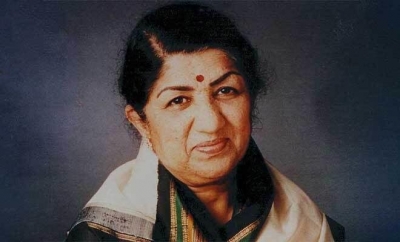By Amit KhannaNew Delhi, Feb 8 : For nearly eight decades, Lata Mangeshkar defined Hindi film music.Diminutive, Indore-born Lata was literally nurtured in music.
Her father Dinanath Mangeshkar ran a theatre company and later did did music concerts.So, a two-year-old Lata would sit by her father’s side while he did his daily riyaaz.
By the time she was 5, she would warble abhangs and other songs from her father’s repertory of classical and traditional songs.Lata was the eldest of the 5 Mangeshkar siblings — Asha, Meena, Usha and Hridaynath.
Incidentally all would grow up and make a name for themselves.
Unfortunately, after some professional disasters, Dinanath died leaving the family destitute in 1942.
All the responsibility fell on 13-year-old Lata.She had appeared in bit roles till then but now she needed more work.
Family friend Master Vinayak (father of actress Nanda) came forward to help.He helped the young Lata get her a break in friend Vasant Joglekar’s film Kittie Ha Saal in 1942.
She started working in Master Vinayak’s company Navyug Chitrapat.
In 1945, this company moved to Mumbai and the young Lata too followed.
While the initial days were of tremendous struggle Lata started learning classical music under Ustad Aman Ali Khan of Bhindi Bazaar Gharana.
In 1946, she got her first Hindi film in Vasant Joglekar’s Aap ki Seva Mein (1945).
She kept on doing an odd song or the other until Master Ghulam Haider (Better known as the composer of Kamal Amrohi’s Pakeezah) became her mentor and got her a job in Bombay Talkies and her first hit was in Majboor in 1948 where Gulam Haider gave the music.
Haider also got her to improve her Urdu diction.
In 1948, she got her big breakthrough in Ziddi.The breakthrough came in Bombay Talkies.
Her fist big film was Ziddi starring Dev Anand and Kamini Kaushal with music by SD Burman (Kishore Kumar too got his break in this film) as a singer followed by Buzdil, both in 1948 and in 1949 the super hit Ayega Aanewala in “Mahal”.
This Kamal Amrohi film had music by Khemchand Prakash.Lata’s rise to the top thereafter was swift.
She soon became the default choice as the playback singer for most leading ladies and composers.
Once Bade Ghulam Ali Khan said about her “Kambakth kabhi sur nahin chhodti” — damn, she never drops a note.
From the fifties to the eighties, Lata delivered hundreds of hit songs under various composers.
She was the first choice of filmmakers like Mehboob Khan, V Shantaram, Bimal Roy, Raj Kapoor, the Anand brothers, Chetan, Dev and Vijay), Raj Khosla, Yash Chopra, Amiya Chakravarty, LV Prasad.
Let us not forget this was the golden age of Hindi film music with composers like Anil Biswas, Naushad, SD Burman, Khemchand Prakash, C Ramchandra.
Shanker Jaikishen, Roshan, Madan Mohan, Khayyam, Salil Chowdhury, Vasant Desai , Hemant Kumar, Ravi, Kalyanji Anandji Burman, Laxmikant-Pyarelal and later Rajesh Roshan,Bappi Lahiri and Anu Malik.
Poets like Sahir, Shailendra, Majrooh, Shakeel, Kaifi , Indeevar and Anand Bakshi were also among the some of the most talked-about individuals.
Among the singers, we had Suraiya, Geeta Dutt, Asha Bhosle , Shamshad Begum and Suman Kalyanpur, among women and Mohamad Rafi , Kishore Kumar, Mukesh, Hemant Kumar, Talat Mehmood and Manna Dey, Lata Mangeshkar was the voice most heard and liked in India.
Lata Mangeshkar never married though there were whispers about her liaison with C Ramachandra, Raj Kapoor, Jaikishen and an extended close friendship with cricketer-prince Raj Singh Dungarpur.
Such was her respect that such innuendo never impacted her image.She would come to the studio dressed in exquisite white sarees with a prominent bindi carrying a thermos of warm water.
Rarely would she ask for a cup of tea.
She did not socialize much and spent most of her time with her family doting on her mother and nieces and nephews.Cricket and photography were favourite hobbies though she could whip up a mean dinner if required
I got to know her in my early days in Navketan but came closer to her once I turned a lyricist n 1973.In fact she sang the first song I wrote Dur Dur tum rahe for which she got the West Bengal Film Journalists’s award.
Over time she got fond of me partly because I was the youngest lyric writer and partly because of the language which was a little different from the conventional Hindi/Urdu used in film songs.It was only after a couple of years of working together that she opened up.
She would talk about her travels or indulge in some mild gossip about other film folk but usually she would come to rehearse the song and go to the mike and in a couple of takes the song would be okayed and she would leave.
One thing I noticed that she would always exchange a few words with some of the senior musicians whom she knew for decades.
She was not political in an overt sense of the word but was a nationalist.She was proud to be Indian and was not willing to accept needless criticism of the nation or its rulers.
A couple of times I spoke to her about it she was aware of what was happening in the world.She was also familiar with global music trends.
While she respected classical performers and singers, she was not intimidated by anyone.She doted on her family special the kids of her siblings.
There are several stories going around since the 1950s about how the Mangeshkar sisters obstructed the entry of new comers.This is patently wrong.
They were loyal to some composers and felt betrayed if a song created for them was handed over to another singer on account of their unviability on a particular day.
In fact, there are many young singers who were encouraged by Lata and Asha.She was willing to take a stand when required.She was the first singer after KL Saigal who insisted for a share of royalty for each of her songs.
When Rafi compromised, she stopped singing duets with him for a number oof years.Similarly, she took offence to a comment need by OP Nayyar about her voice quality.
She never sang for him ever.She never sang a single song of the talented composer.
Similarly, once she had some creative differences with SD Burman and they did not work together for 5 years.
What is it that makes Lata Mangeshkar stand amongst not only her contemporaries but also singers from earlier and later periods? One is her voice which is a natural gift-soft, dulcet and very malleable.The second is her ability to feel the words she sang.
She could sing a romantic song with as much ease as she sang a ghazal, bhajan or lullaby.
In fact, I can say with confidence she is the only singer who would improve upon the original composition of the music director.
She could embellish the song with right murki, harkat or a mere emphasis on a particular word.Her enunciation was impeccable.It’s a wrong notion that she rehearsed a lot.In the 50s it was a tradition for the singers to go to a music director’s music room for rehearsal.Somehow this practice faded away by the 70s.
Lata Didi could give perfect take after a mere 15 minutes rehearsal.When she really a particular composition she would call the compose and asked him to come home for a rehearsal.
To sing faultlessly for almost 8 decades is an unparalleled achievement.There were perhaps a dozen composers and half a dozen lyricist and, a few film makers with whom Lata had a special relationship but her professionalism was there for every singer, writer, composer, arranger or orchestra with whom she worked.
I am often asked about Lata’s best songs.When an artiste’s repertoire runs into thousands it is very difficult to pick a handful of her songs.
A few of my favourites (not exclusively)at random are Ayega Aanewala, Na Jaane Kahan Kho gaye, Ai ri main toh prem diwaniya, Zindagi usi ki hai, Phaili hui hain sapnon ki bahen, Bekas pe karam kijeye, Ajeeb Dastan hai yeh, O basanti pawan pagal, Allah tero naam, Kahin deep jale kahin dil, Mere Mehboob tujhe, Jogi Re jao re, Naina Barse, Lag ja gale, Bindiya chamkegi, Aaj phir jeene ki, Phool tumhe bheja hai, Chalo Sajna, Kaise rahoon chup, Baharon mera aanchal bhi sanwaro, Bahon mein chale aao, Rangila Re, Ye galiyan ye chaubara, Ehsan Tera hoga mujh par, Yashomati Maiyya se, Didi Tera devar deewana, Tujhe dekha toh, Kabhi Khushi Kabhi gham and two of my lyrics – Pal bhar me ye kya ho gaya and Suman Sudha Rajni chanda .
(Amit Khanna is a Lyricist, Writer and Film Maker)
amit/pgh
#Lata #Mangeshkar #Indias #Goddess #Delhi #Mumbai #Cricket #BCCI #ICC #IPL #Sports # Yash #Amit Khanna #Bappi Lahiri #Dev Anand #Kishore Kumar #Mehmood #Raj Kapoor #Kishore #Manna Dey #Master Vinayak #Mukesh #Prem #Yash #Geeta Dutt #Kamini Kaushal #Meena #Suraiya # Suraiya # Kamini Kaushal # Meena #Anand #Lal #Mohan #Rajesh # Diya #Miya # Sudha # Usha #Jan #Suman #Ali # Lal # Diya #Mehmood #Gaya #Delhi #New Delhi #Mumbai #West Bengal #Zen #Kapoor #Song
.






